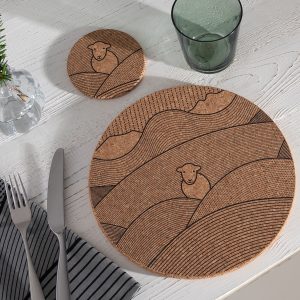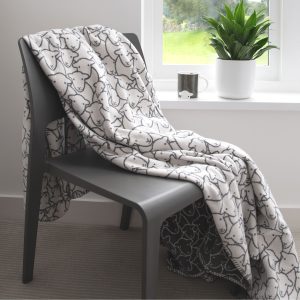We hope you think the most interesting thing about the towns and villages that are home to our herdy shops are the shops themselves, but there is actually much more to them than that. Cumbria is full of fascinating facts and hidden things to discover; here are just a few of our favourites.
Grasmere
Wordsworth is the most obvious “claim to fame” for Grasmere and many people visit the family graves in St Oswald’s Church as well as nearby Dove Cottage. But few people visit another quirky memorial to Wordsworth: a large water trough next to the mini roundabout as you enter the village.
Wordsworth was one of the people who led the fight against a railway line running from Windermere to Keswick; this resulted in the current A591 being one of the last coach routes in England. Horses need water like cars need petrol so a water trough memorial was a popular way to commemorate important people, and this one is definitely worth a look.
Grasmere is also home to two important events that are deeply woven into the history and culture of Cumbria: the Rushbearing Festival in mid July (this year it’s 14th–20th) and Grasmere Sports on August Bank Holiday weekend. The Rushbearing dates back to the days when church floors were simply made of earth, and rushes were used as a covering and to freshen up the air; each year a procession of children in traditional clothes winds through the village carrying rushes to be laid on the church floor.
Grasmere Sports began as a sheep fair in the mid 19th century. Back then, in the days before cars and phones, farming the fells could be a pretty lonely business and these fairs were an important community event—a chance to catch up with old friends and perhaps return the odd stray sheep or two. Over the years it’s evolved and today you can enjoy a variety of traditional events, including Cumberland and Westmorland Wrestling.
Keswick
As you can imagine, Keswick is a magnet for all things outdoors and adventurous, and there is little more challenging than the Bob Graham Round, which begins and ends at Moot Hall in the centre of the town. The Bob Graham Round is a fell running challenge which involves completing a 66-mile run, covering 42 of the highest fells, in under 24 hours. Only a third of people who set out on the challenge manage to complete it. Attempts usually begin very early in the mornings and finish very late at night, so if you happen to spot a crowd of excited people hanging around the outside of Moot Hall, it’s worth sticking around as it’s quite something to see someone finish.
For something rather more relaxing take a walk to Friar’s Crag—an easy stroll from the town centre and possibly one of the most popular viewing spots in the whole of the county. What many people miss is the fact that this is a memorial to John Ruskin, a 19th century thinker and writer who once described Keswick as “…almost too beautiful to live in.” Long before they became a reality Ruskin called for free libraries, free schooling, and free healthcare. He lived in Brantwood on the shores of nearby Coniston Water and his house there is also worth a visit.
And if shopping is more your thing then you’ll enjoy Keswick Market on Thursdays and Saturdays when the whole town buzzes and the square is crammed full of local traders. The market dates all the way back to 1276 when Edward I granted the town its market charter and it’s the perfect place to stock up on local food and drink before a visit to the herdy shop.
Bowness-on-Windermere
Bowness sits roughly halfway along Windermere and is a beautiful spot which attracts thousands of visitors every year. “Bowness” means “headland where the bull grazes” and most likely refers to the large headland jutting out into the lake, though the bull is long gone. Readers of Swallows and Amazons may recognise it as “Rio” from the book, and the 1973 film used the town extensively with many film locations easily identifiable today.
The steamers that stop in the town originally began as a way for the Furness Railway Company to make additional money during the early part of the 20th century. The line from Barrow to Lancaster originally made most of its money from moving goods, but when that began to dwindle the owners got creative. They began bringing day trippers across Morecambe Bay from Fleetwood to Ulverston, then taking them by train to the bottom of Windermere and then onto a boat all the way to Ambleside, via Bowness—most of the boats on the route date back to the late 1800s.
Orrest Head is a short(ish) walk from Bowness but is perhaps one of the most important views in the Lake District. In 1930 Alfred Wainwright, a 23-year old accountant from Blackburn Borough Council, first visited the area and climbed to the top of Orrest Head. He was so inspired by the views that he moved to the county and went on to write his seven volumes of Lake District walks and other assorted books on the region. Good job it wasn’t raining that day!
Kendal
Kendal takes its name from the River Kent running through the centre of the town (Kent Dale = Kendal). Probably the most famous thing associated with Kendal is the Mint Cake, which Sir Edmund Hillary took with him when he first conquered Everest. The recipe reputedly comes from a culinary mistake when someone left a batch of glacier mint mix to go cold overnight. Romney’s is probably the best known of the current producers but, back in the day, most local families would have had their own recipe, which was handed down through the generations. Today you can still find Kendal Mint Cake in most shops in the county and, if you fancy something a little stronger, you can also buy Kendal Mint Cake Liqueur—just look out for the bright green drink in local bars.
The town also boasts two castles, although there’s not much left of the first one. Castle Howe, on the east side of town, is a Motte and Bailey castle dating back to the 11th century. Kendal Castle, on the west side of the town, dates back to the 13th century and there’s much more of it to see. The second castle was once home to the Parr family and Katherine Parr went on to become Queen of England when she married Henry VIII.
Much of the history of the town is connected to the wool industry and there are dozens of tiny passages winding down from the high street to the river. These would have been used by wool merchants to wash the fleeces and, in some places, the steps down into the river can still be seen. The clothing made from this wool was often rough and scratchy and was known as “Kendal Bumps”, the term was also used in the first part of the 20th century to refer to visitors wearing their newly purchased outdoor clothes.





